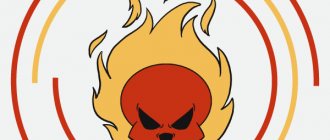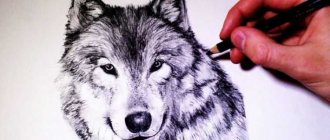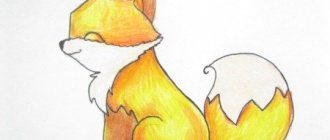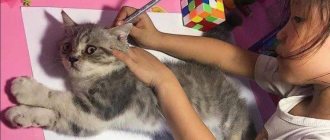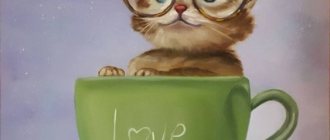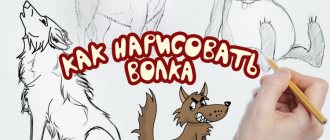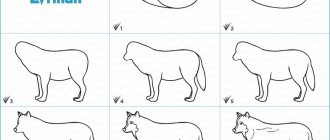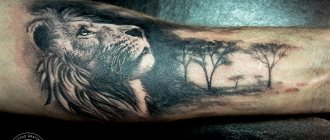Drawing on the cell
To draw a skull cell by cell, you need to have patience and a clean sheet of paper. A steady pencil needs to be sharpened sharply. First you need to position the sheet of paper so that you can start drawing at the top side of the sheet.
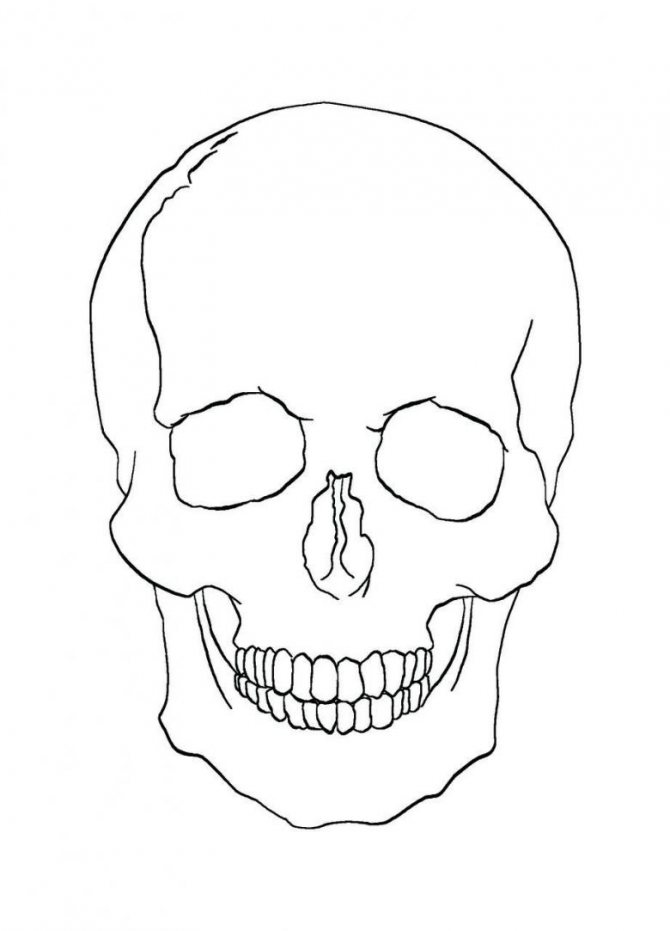
In a horizontal position it is necessary to draw a long line. Its size depends on how big the skull illustrator is going to do. If he is going to depict a small skull, it will be sufficient to draw a line of three cells. On the sides of the sketch you need to put vertical dashes of the length that the entire skull should be. Next, these dashes should be connected by an oval line.
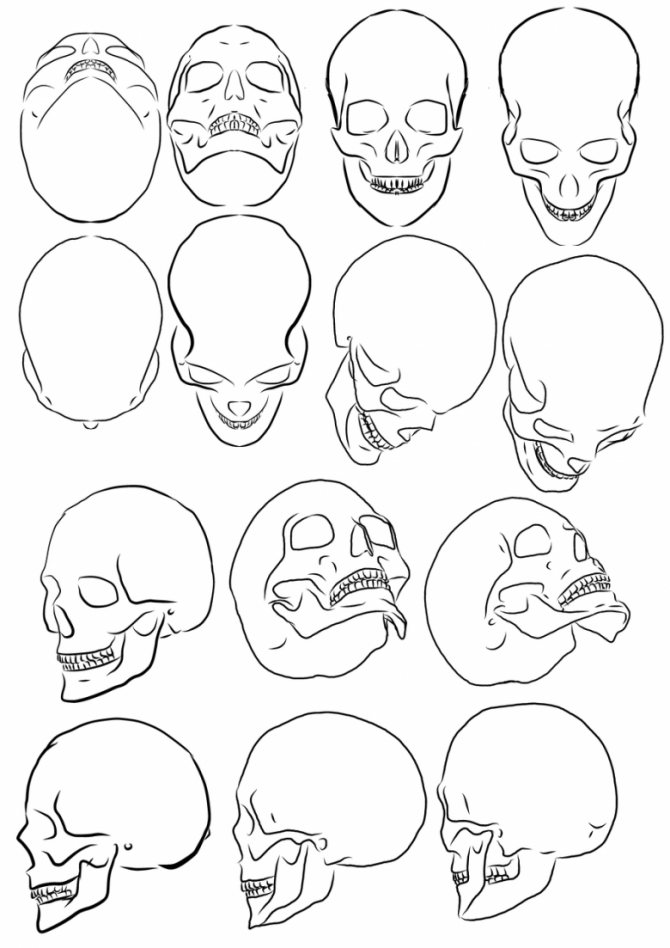

The second step of drawing the skull is to draw the eyes inside the image of the head. After these operations it is necessary to draw one straight line on the underside. On this straight line we begin to draw the teeth. When the silhouettes of the eyes are painted and the teeth are drawn, the drawing can be considered finished.


Skull with swords
The second version of the skull outline is a little more complicated than the previous one. First, you need to draw a slanted segment in the left edge of the sheet. To it you need to add a vertical pencil sketch. To this part of the work it is necessary to add the outline of the sword handle.
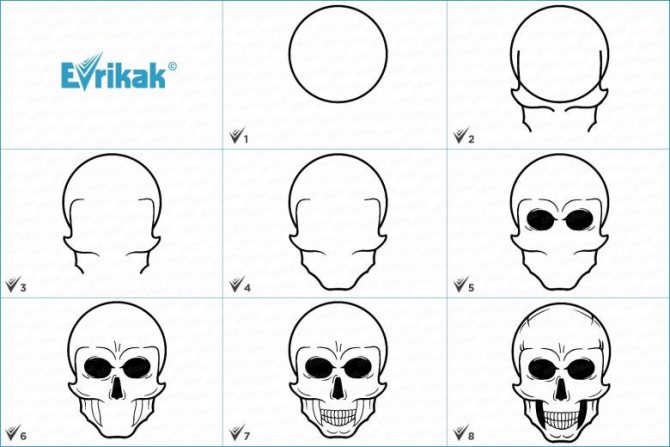

Next, complete the work with the bottom part of the bone. Next, another part of the sword handle needs to be drawn. It is necessary to draw a line up and deduce the line of the sword. The next step is detailing the drawing. In the middle area of the skull it is necessary to draw a line that will divide the facial bone into equal zones. The next step is to outline the handle of the weapon.


In the final step of creating a drawing, you need to draw the teeth to the skull. Cracks can be outlined in the frontal and zygomatic area. The cracks will give the skull picture a natural appearance. The next step is to draw the eyes in the outlined circle. On the skull, you need to draw the hollow of the nose and detail the handles of the weapon behind the skull.
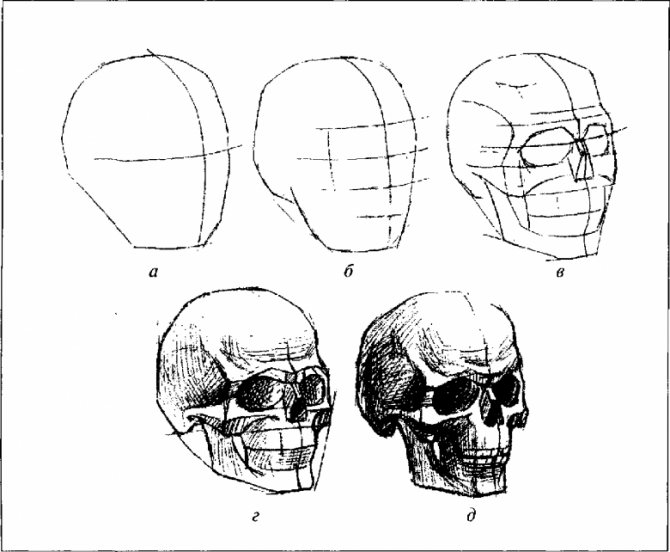

To give a more saturated shade to the drawing, it is necessary to trace the outline of the skull with a marker. Areas that require a more saturated drawing should be painted over with black felt-tip marker.
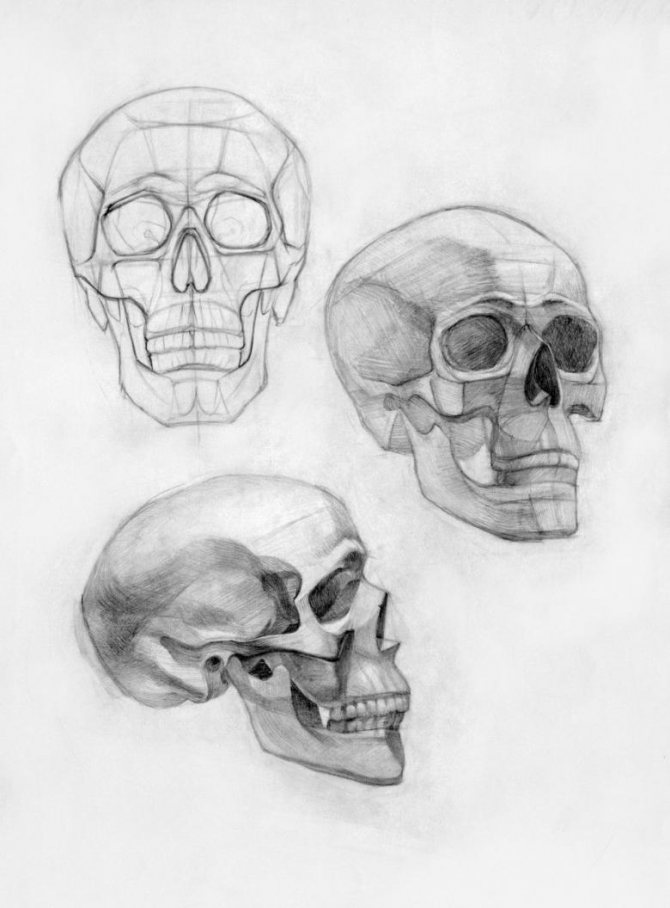

How to draw a human skull in the fire
I got carried away by the fire effects, but I could not miss this lesson.
I got the picture of the skull from www.designious.com, you can also get it here. I also need fire images here (not hard to find on the internet).
So, let's get started.
Create a new image of the size of 210mm*290mm
, with a black background.
Copy Ctrl+C
and paste
Ctrl+V
vector image from Illustrator into Photoshop.
Create a new layer, draw an oval on it and fill it with the color #4c0400
. Place it behind the skull and apply the filter
Filter > Blur > Gaussian Blur
with the parameter
250px
.
Use Select > Color Range
function, select the white color on the skull and paint over it in orange.
#f9ae31
. Color the teeth and lower jaw in red -
#e82b19
.
Next, select the red areas of the image Select > Color Range
and shrink the selection using
Select > Modify > Contract
to
4 px
. Press the
Delete
button to delete.
Now make a selection in yellow. Using a soft brush of size 250-300 px
,
Hardness - 0
,
Opacity - 10-15%
, the color red -
#d02207
paint over the areas of the skull, giving it a glow.
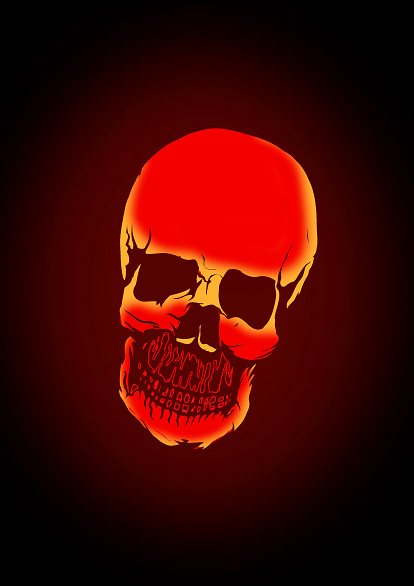

The next task before us is to create the volume of the skull. Using the tool (Eraser Tool) Eraser Tool
(Parameters:
diameter - 200px
,
Hardness - 0
,
Opacity - 70%
) erase some parts of the red glow, creating a transparent fading effect.
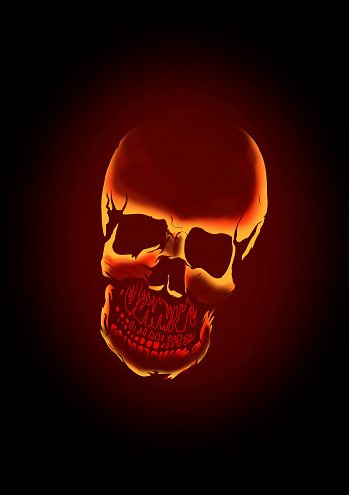

Duplicate the layer with the skull Ctrl+J
. Select the one below and apply the
Gaussian Blur
(Parameters:
8-10 px
).
Select the area under the nose, including the teeth. With the brush tool (brush tool
) in red.
#d02207
- tint on the right and left, creating a soft gradient.
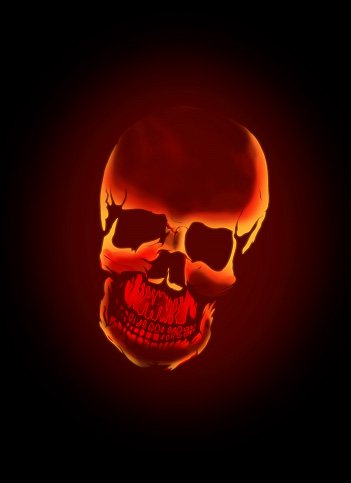

Now let's work on the fire. Open the image of fire.
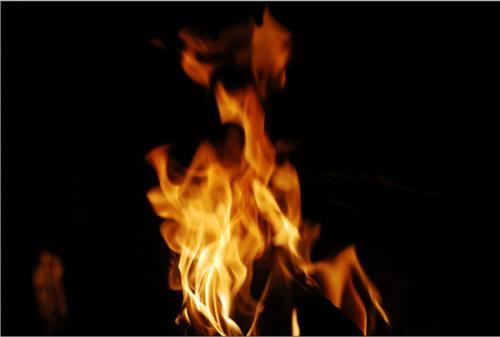

Use Select > Color Range
and select the dark parts of the background. Invert the selection
Ctrl+Shift+I
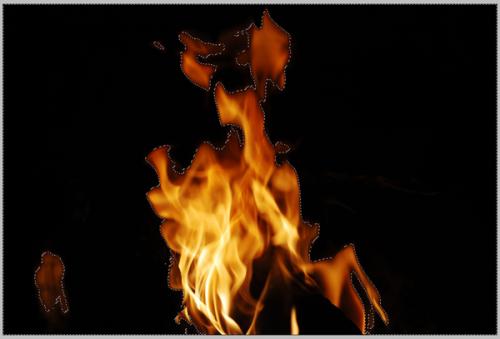

Now Select > Modify > Feather
with the parameter
20px
. Import the selection into the main document with the skull.
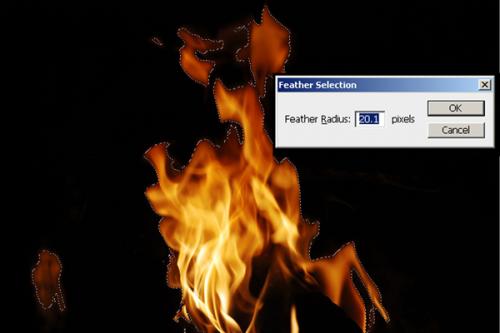

Set the blending mode of the fire layer to Screen
or
Lighten
.
Finally, adjust the color balance in Image > Adjustments > Color Balance
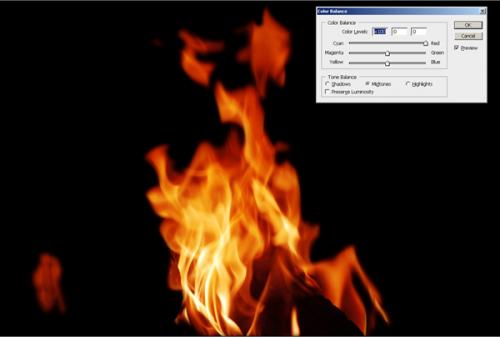

Using Transformation Free Transform
(
Ctrl+T
) place the flame in the desired position and scale it to fit the size of the skull.
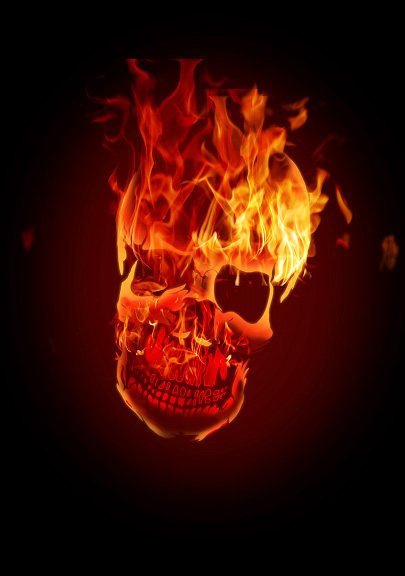

The teeth in the image look a bit darker than the rest of the skull, because we toned them in red. Rub these areas with a translucent eraser to lighten the teeth so they can blend in with the color of the flames.
Use the Smudge Tool
Smudge the fiery areas near the eyeballs to create a smooth transition from the skull to the flames.
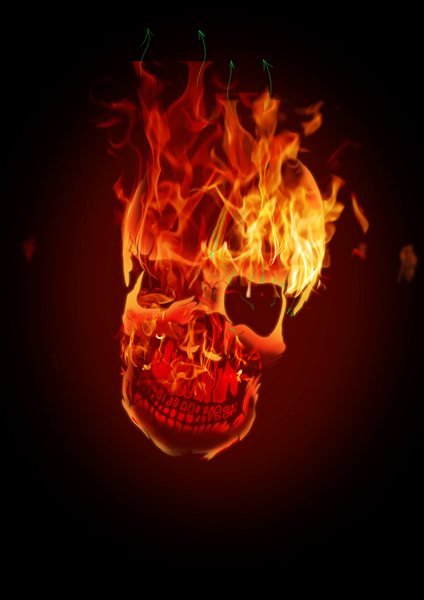

With the same tool - Smudge Tool
- tool to blend the yellow areas of the skull with the flames.
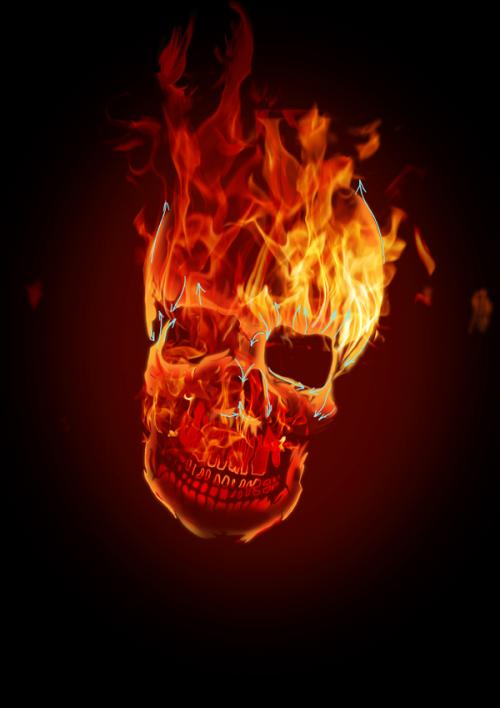

Now blend the red shadow areas, giving a contour to the skull.
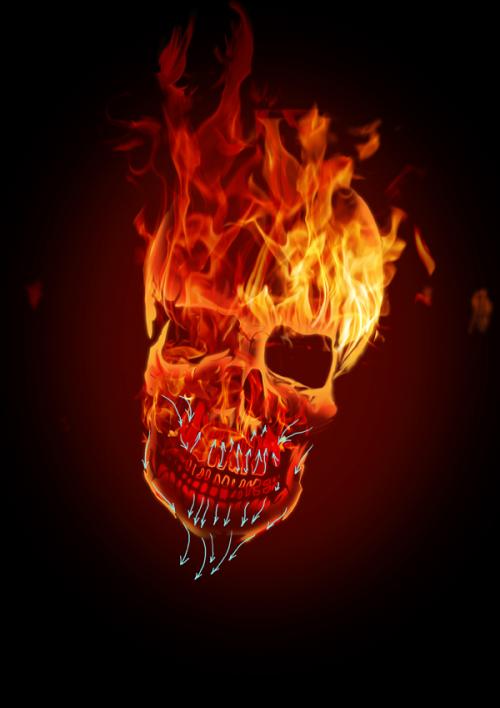

Use the tool Dodge Tool
tool to lighten the outline of the skull.
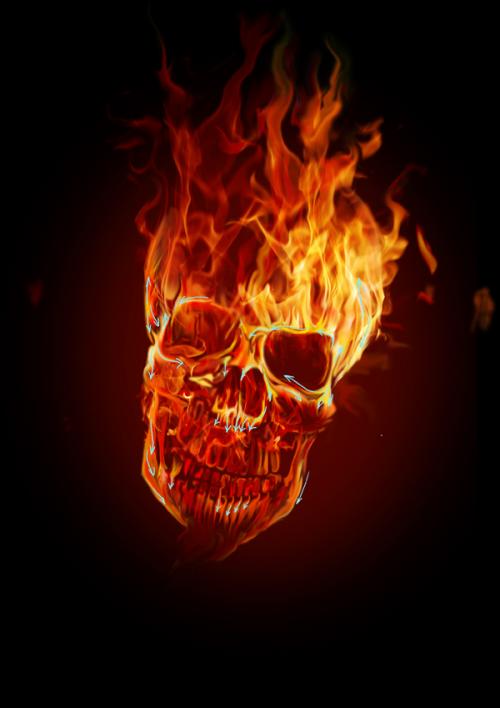

Using the Burn Tool
tool to create shadows along the contour. Using the
Smudge Tool
to give a smooth transition from light to shadow.
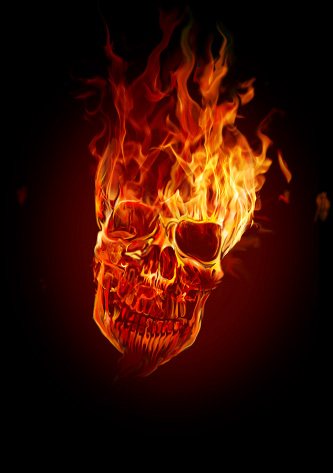

Now add smoke. Use the same selection methods as for fire. The only difference is that you will have to decolorize the smoke image with Image > Adjustments > Hue/Saturation - Saturation - (-100), Luminosity - (-16)


Apply Filter > Blur > Gaussian Blur
- with the setting of
2 px
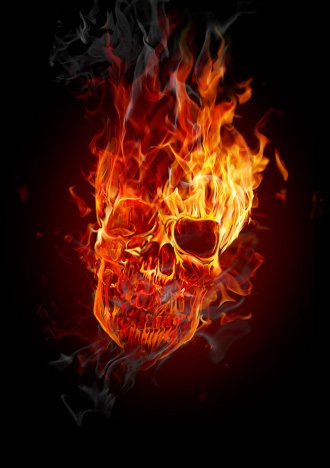

You can add some sparkle by using a solid brush of size 3px
(Parameters:
Hardness - 100%
,
Opacity - 100%
). You can smudge a little with the
Smudge Tool
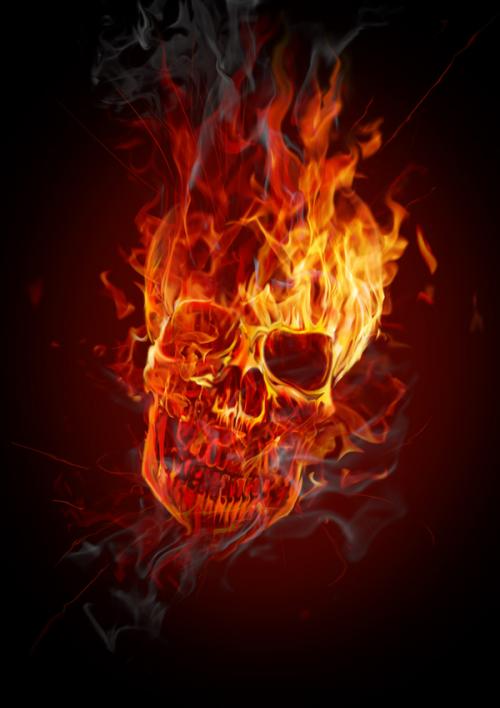

If you find a mistake/print, please highlight the text fragment and press Ctrl+Enter.
Graffiti on paper
A more complicated variant of skull outlining is graffiti. For this kind of work you need to buy a pencil and a black marker. Start drawing from the middle area of the paper. Draw a silhouette of fire, which will later correspond to the depression of the nose. At the top of this depression we draw a wave. On both sides of this wave you need to add circles. These circles can be irregularly shaped. They are prepared for tracing eye sockets.
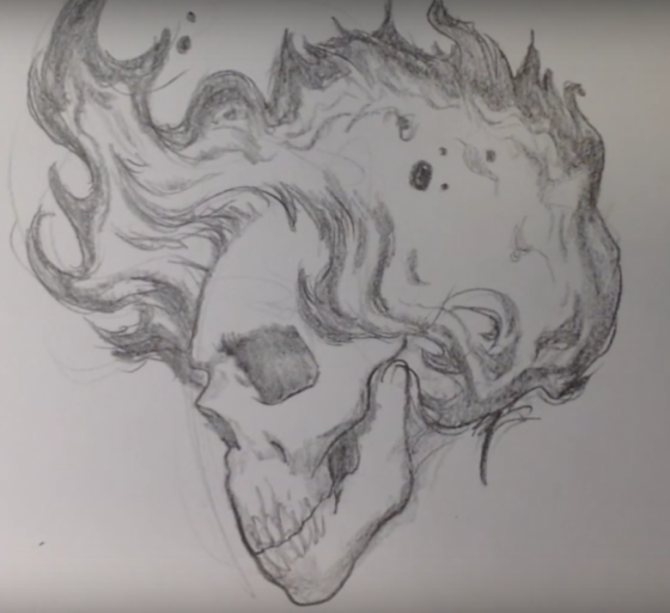

To add artistry to the drawing it is necessary to seal some lines. After a number of simple operations necessary to deduce around the finished nose and eye sockets skull lines. Below derive the jaw with teeth. Teeth should not be symmetrical relative to each other. Artistry figure adds uneven lines of teeth.
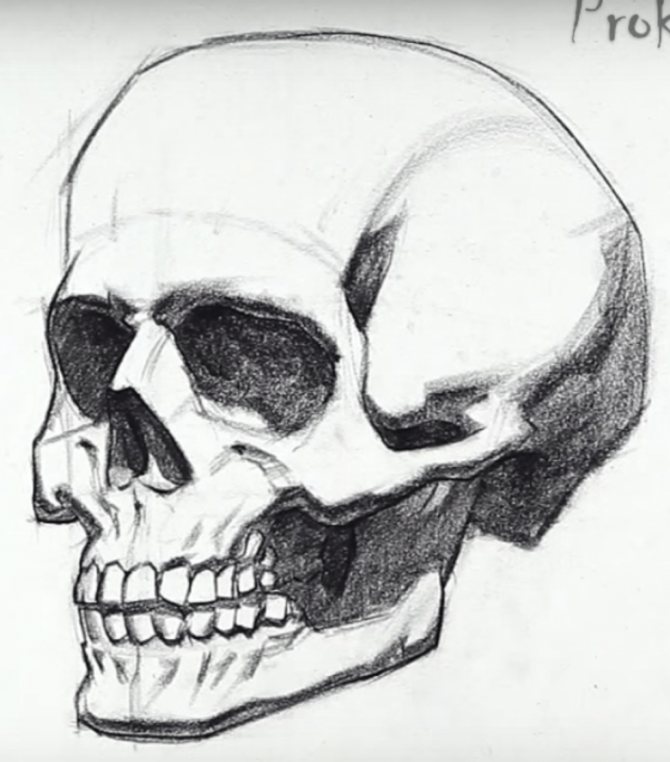

If desired, you can "put" on a skull cap. It is outlined step by step. First, vertical lines are drawn upwards, and several horizontal lines are drawn perpendicular to them. According to the artist's vision, the thick lines of the cap and the painted areas of the cap are refined. It is best to paint over the areas with a prepared marker.


It is possible to add a tattoo to a skull image to create a poetic drawing. The tattoo can be anything. From the great variety of drawings it is possible to choose exactly the one that will convey the author's idea.
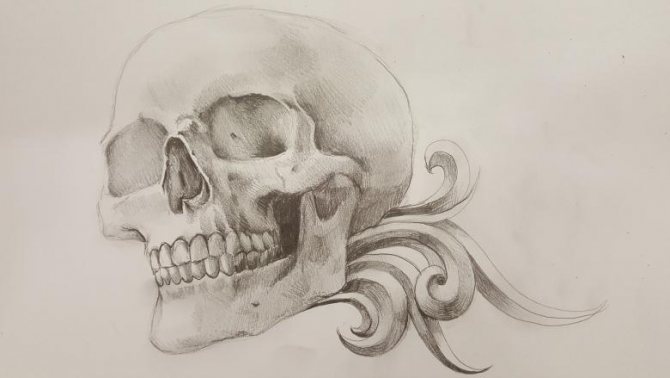

Skull drawing
One of the common gothic images of the skull can be considered a drawing of the skull in the hood. This image often illustrates dark forces in many comic magazines. The hooded skull drawing should begin with a drawing of the shape of the nose. On the sides of the nose, the hollows of the eyes must be drawn. Next, it is necessary to outline the border of the head under the hood.
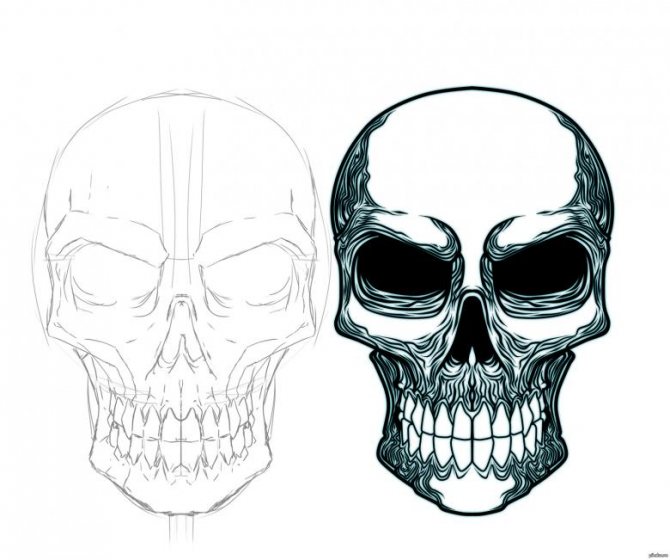

It is important to competently outline the cheekbones of the skull. The jaw is outlined from the cheekbones. The teeth inside the skull's mouth can be uniform, or they can be uneven. Sometimes gaps in the teeth line are left on purpose. Often artists resort to this to create an extravagant look. This is especially applicable in creating drawings for creative magazines.
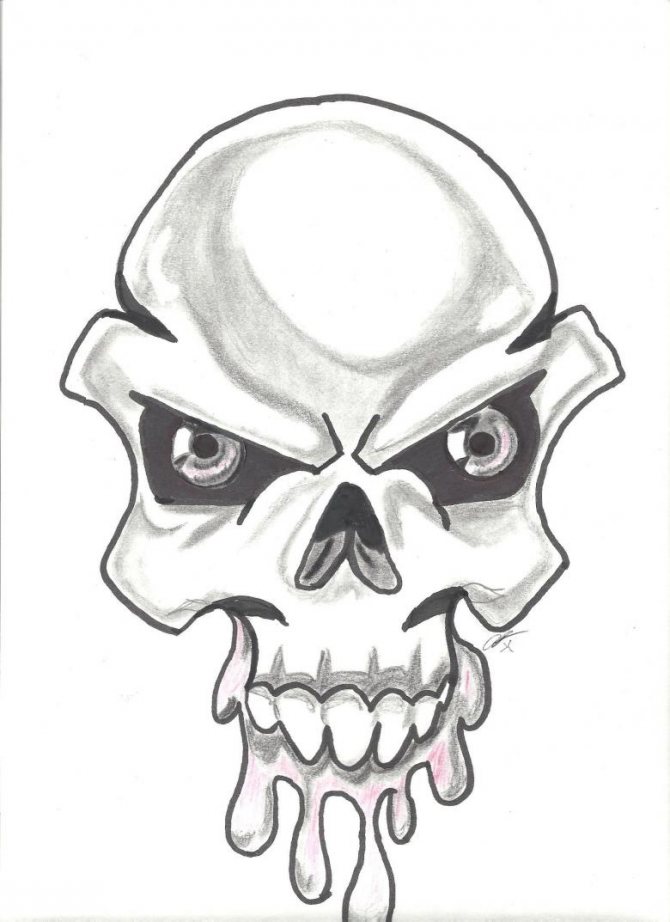

The entire skeleton can also be drawn to the skull. If the creative idea requires it, you can add clothing and other elements to the image. There are many drawings of skulls and skeletons on the Internet. The artist's imagination is limitless when it comes to human anatomy.
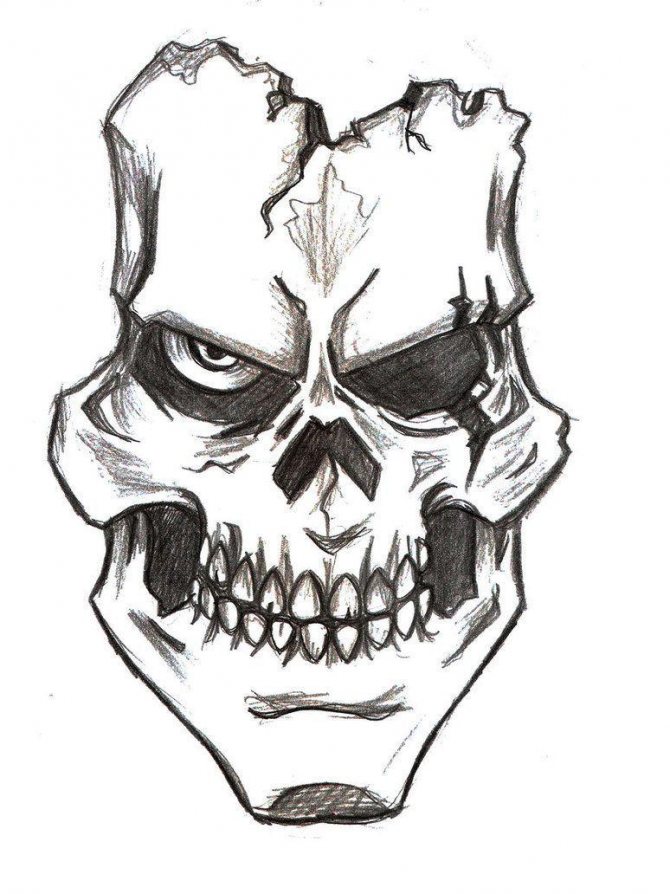

The image of the skull as a sacred symbol is found in the religions of many peoples. Tribes in Africa and the Americas use the skull as an accessory or utensil. According to beliefs, the skull is an amulet that protects its wearer from negative energy and contributes to the successful completion of cases. In more civilized countries the image of the skull is pinned on the skin. You can find variations of such a drawing in free access on the Internet.
https://youtu.be/Web2m70D6Ighttps
://youtu.be/uJRgpgMYvvM
"The skull has soared, the doll has spoken..."
This
probablytrue, but fairy tale-like, story began a thousand years ago and is still not over.
At the end of her reign Catherine the Great deprived by royal decree the property rights of the noble son Alexei Kruglov, and he himself was assigned to the Yellow House for "tales, hot and lying against God". Prior to that, Kruglov, who fell out of favor, was repeatedly interrogated, his testimony was written down, the empress became acquainted with them, and her verdict was: "The rougher the lie, the faster it finds its way to the heart.


To prove his innocence, Krugloe delivered to the monarch's throne a casket with a man-made skull, which was the sole cause of all his misfortunes. This curiosity caused a sensation at court.
Here is how an eyewitness described it: "The lid of the chest was torn off. The boxwood was glowing like coal inside. The heat was on. The skull soared above the box. "The translucency of the skull became extraordinary. We saw pictures of hell, where people are like us, but not like us. They were over-head, hollow, and everything like creeping creatures and insects. And the cities were good, glittering with stones, floating in the air. Every eye-hole of skull showed us its world. A wondrous world. The skull, when it had calmed down, cooled down. We sealed it in a casket so we would never remember it again.
Catherine 11 returned to Kruglov his favors, and, of course, asked where, when and under what circumstances he got the artifact.
A terrible find and a legend
According to the sworn testimony of Alexey Kruglov, he found the "demon skull" in an old abandoned rural house, where it was driven by bad weather. The dilapidated house, where Krugloe took refuge from the raging elements, stood at the edge of a dark forest and had long had a bad reputation among the locals. There, among the dust and mustiness, Alexei found several skulls, three of which were so decrepit that they crumbled into ashes as soon as he picked them up, and the fourth, the one he had taken with him to Peter, where he used it as a paperweight, which was the fashion then. One evening he noticed that this skull periodically had some strange directions in it.
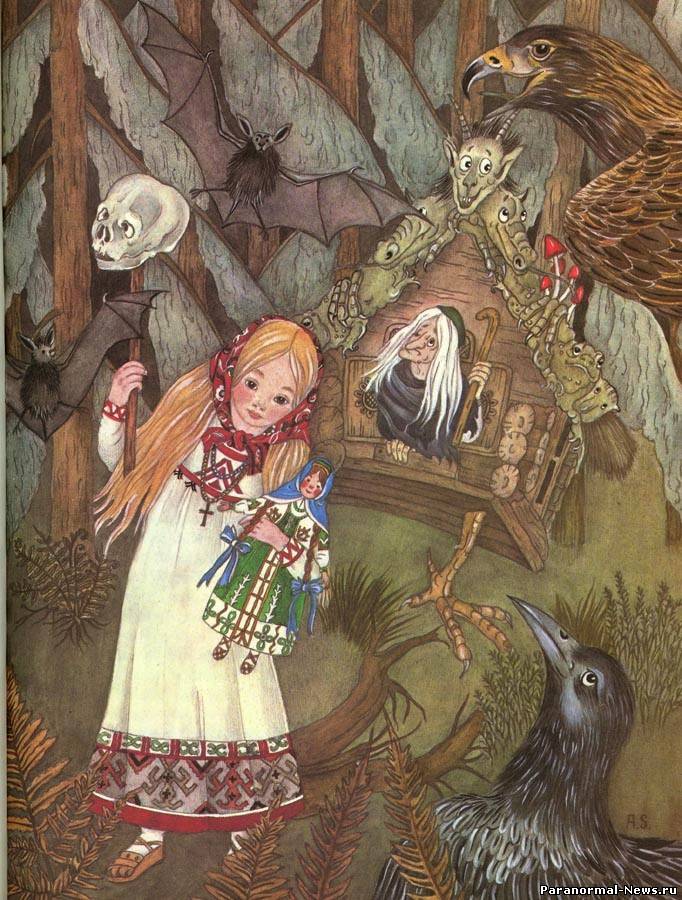

Many years later the writer Vladimir Fedorovich Odoevsky, a nephew of the Decembrist Alexander Odoevsky, wrote a mystical novel "Kosarama" based on A. Kruglov's adventures. This novel was filmed shortly before the collapse of the USSR under the title "The Devoted One."
In Russian folklore, there is a magical tale "Vasilisa the Beautiful", in which the skull sizzles the lichodeks. I would venture to guess that Krugloe found the very skull in question in this fairy tale. And here's its plot in a nutshell.
Russian Cinderella - Vasilisa the Beautiful
A merchant had an only child, Vassilisa the Beautiful. When the girl was eight, her mother died. As she was dying, the mother called her daughter to her, took out a doll from under her blanket, and said: "Listen, Vasilisushka! Remember and fulfill my last words. I am dying and I leave this doll with my parental blessing; keep it always with you and never show it to anyone; and when some misfortune happens, give it something to eat and ask its advice. She will eat and tell how to help the misfortune.
Then the mother kissed her daughter and died. After the merchant married a widow with two daughters who were the same age as Vasilisa. The stepmother and her daughters did not like her stepdaughter and began to make her do all the housework. It would be hard for Vasilisa, but she was helped by a doll, who not only did almost all the work for her, but also supported her morally. But sometimes Vasilisa wouldn't finish her own meal, and she would leave the tastiest bite with the doll.
Although Vasilisa's stepmother and her daughters did nothing at home, but sat idly by, they lost weight and grew sickly with anger: women often have metabolic disorders on a nervous basis. One day the merchant was away from home on business for a long time. The stepmother then moved to another house, near a dense forest, where Baba Yaga lived in a hut and ate people like chickens.
One autumn evening the stepmother sat the girls down for needlework. She put out the fire in the whole house, leaving the only candle where the girls were working, and went to bed herself. One of the stepmother's daughters, at the order of her mother, as if by accident, put out the candle. Stepmother's daughters escorted Vasilisa to Baba Yaga for fire. She, of course, in tears, went to his closet, put the dinner prepared in front of the doll and told her that she was sent to Baba Yaga for fire, to certain death. The dolly ate, her eyes shining like candles. "Don't be afraid, Vasilisushka! - she said. - Nothing will happen to me at Baba Yaga's!" Vasilisa put the doll in her pocket and went into the woods.
She walked for a long time: all night, morning, and afternoon. There were strange encounters along the way. And only at dusk Vasilisa came to the glade, where the hut of Baba Yaga stood: a fence around the hut of human bones, human skulls stick out on the fence, human legs instead of doors at the gate, hands instead of locks, instead of a lock - a mouth with sharp teeth. Vasilisa was dumbfounded with horror and stood as if she had stood still. Night fell. But the darkness did not last long; the eyes of all the skulls on the fence lit up, and the whole clearing became as bright as daylight. Meeting Baba Yaga, Vasilisa explained to her politely that her stepmother's daughters had sent her to get fire.
-"Well," said Baba Yaga, "I know them; but live in advance and work for me, then I will give you fire, and if not, then I will eat you!
In short, for several days Baba Yaga would assign Vasilisa a knowingly impossible job, for example, to clean the poppy, which Baba Yaga had full pockets, one grain at a time from the ground. All this work in the absence of Baba Yaga, who left his hut on chicken legs in the morning, and returned only late in the evening performed doll Vasilisa, her mistress only had to prepare food and serve them. On the third day, during dinner, Baba Yaga struck up a conversation with her guest worker.
In the end, learning that Vasilisa manages to do the work assigned to her with her mother's blessing, Baba Yaga came into a wild rage, dragged the "blessed daughter" out of the upper room and pushed her out of the gate; then she took a skull with glowing eyes from the fence and put it on a stick: "Here is fire for your stepmother's daughters, take it: they sent you for it!" Vasilisa rushed from this cursed place, lighting her way with her skull like a lantern. Well, how she did not hurry, and only the next evening she came out to her stepmother's house.
She walks and thinks: "Probably the fire is no longer needed, so much time has passed, I'll throw the skull...". At the same moment a muffled voice came out of her skull: "Don't leave me, bring me to my stepmother!" For the first time in all this time Vasilisa was greeted by her "in-laws" in a friendly way and they explained that since the time she went away, they had no fire in the house: they could not make a fire themselves, and those brought from neighbors - it went out as soon as they brought it into the upper room. "Maybe your fire will hold!" - said the stepmother.
They brought the skull into the upper room, and the eyes of the skull stared at the stepmother and her daughters, and burned. They tried to hide, but wherever they rushed, their eyes followed them everywhere; in the morning they were burnt to ashes, only Vasilisa was untouched.
It is amazing, but in the Mayan pre-colonial period there was a similar "ritual of the skull" about which the unknown narrator of the tale "Vasilisa the Beautiful", of course, could not know.
The images of the above described ritual have survived to our days, about this ritual, however, with a certain skepticism narrated by Yu. Knorozov, the Soviet scientist who was able to decipher the writings of the ancient Maya.
How it was
Pre-Columbian America, the Yucatan Peninsula, the city-state of Chichen Itza. The red sea of people waves near the stepped pyramid, on the last platform of which today the high priest is performing rituals. Today is a special day. Several Indian warriors, fattened with human meat, drive with their spears the Indian with bound hands in the direction of the pyramid, he resists, but the forces are not equal and soon he is pushed to the top of the pyramid to the priest.
A deadly silence ensues. Suddenly the high priest shouts something guttural and, as if from nowhere, with a practiced movement pulls a ritual skull from the folds of his priestly vestment. For a second he holds it in his outstretched arms. The skull begins to shimmer, and a bright, scorching beam erupts from its mouth and eye sockets, striking the bound Indian. He cries out wildly, his body convulsing. A second and the cramped body, broken by convulsions, falls from the pyramid to the feet of the dispersed crowd.
According to the scientist, the cause of death in this case was fear. The Indians used life-size models of human skulls, masterfully made of rock crystal, to perform this ritual. Legend has it that there were thirteen of them. Four were found in the New World. As shown by experiments, the four aforementioned skulls glow in the dark if they are not far from each other. At one time one of these skulls, the "Jesuit", belonged to Ignatius Loyola, and the other "Skull of Doom" belonged to the writer Frank Dorland.
The receptacle of another's soul.
Ф. Dorland discovered inside the back of the "Skull of the Rock", a system of prisms and channels: if a candle is placed behind the skull, the skull and its eye sockets begin to glow. In addition, the "Skull of the Rock", if held at a certain angle to the sun, the beam will come out of the skull's mouth.
It is known that if you light a fire under the Jesuit, two rays will strike from its eye sockets. But still the skull that Krugloe found is the most mysterious. He to this day is stored in Moscow, in the forensic collection of one of the medical schools. Here's what Professor Victor Zvyagik, an honored doctor of Russia, an employee of the Center of Forensic Medicine, said about it:
- The skull is small. It has a deep hole of 20-25 mm in diameter. The skull is made of an unknown to science translucent crystal. It is not a human skull, nor is it the skull of a primate (humanoid ape). Probably this artifact is supposed to represent the skull of an intelligent inhabitant of another world, possibly an alien.
In his book "Acts and Wisdom of the Ancients" F. Dorland wrote that while he had the "Skull of the Rock", "it sometimes changed color or twitched a soft haze, a strange ringing sound came from it, images of mountains and temples appeared inside it, and once a few minutes it was surrounded by a strange glow. Due to this feature of glowing all of a sudden "skull of the Rock" and was found by archaeologists. All this is also true for the skull of Kruglov, which killed Paul I.
Ominous Paintings
After the death of Catherine the Great, this "skull" was inherited by her half-crazed offspring Paul I. In it he saw the horrors of a bloody war, and not any alien one there, but an earthly one, modern to him. He was so disgusted by the spectacle that Paul I appealed to all European monarchs to solve their conflicts not by war but by fighting like in the olden days of knights. This noble idea: to have a freak fight instead of a battle of nations, caused laughter all over Europe.
And also "skull" showed Paul I, something bad about the Freemasons, for which he banned Freemasonry in his country, although originally he was a Freemason himself, and patronized them in every possible way. For this, the enraged Freemasons spun a conspiracy and killed the emperor.
Shortly before his death, Paul I, gazing into the "skull", uttered: "Strangely, I see myself without an eye." His murderers, the Zubov brothers, knocked out his eye with a snuffbox.
Conclusion
And to finish this story we would like to quote from another fairytale: "Ivan-Tsarevich went to the house of Baba-Yaga, without eating or drinking. He sees that Baba-Yaga's house is surrounded by nine staves, and on each of the eight staves there is a human skull, and only the ninth is unoccupied. Recall, the Indians had thirteen crystal skulls, four were found, one gave Baba Yaga Vasilisa. And this is all a meaningful coincidence, as Carl Jung, the psychiatrist who introduced the concept of the archetype, would say.
And who is the doll from the fairy tale "Vasilisa the Beautiful"? A cyborg? Who knows... "Interesting Newspaper. Magic and Mysticism" №3 2012
